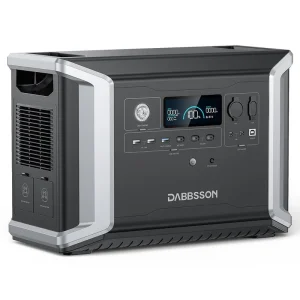If you are someone that travels often, then getting a portable power station can be a great choice. A major benefit is how portable and easy it offers, making this perfect for people who enjoy the outdoors or regions where electricity fails. The portable power station can provide power for laptops, mobile phones and some small appliances. Its capacity falls in the range from 500Wh to 1,500Wh. For the uninitiated, this means that a 1,000Wh unit can charge your smartphone 100 times or power a mini-fridge at 60W continuously for about 16 hours — an ideal tool for camping and emergencies alike.
Portable Power Station: Portable power stations cost $300-$2,000 or more depending on its capacity, features, and brand. Although the price of entry is steep, the long-term rewards may be worth it compared to dealing with a more serious issue down the road. For customers who see the lights often go out, they can save on food spoiling or hotel stays, and portable power stations give a quieter and emissions-free alternative over your standard gas generator. According to a study by Market Research Future, the portable power stations market is expanding at an annual rate of 18% worldwide due to the growing need for consistent backup sources.
According to the company, these stations are not only designed for emergency use, but also for off-the-grid living and travel. Such portability is key for other uses, with RV owners using portable power stations to keep coffee makers brewing or top off batteries on electric bikes. If you also have a 500W motor electric bike, charging it for four hours with ac portable power station. For a power station that can store renewable energy, like solar power in Australian sunburnt skies, the benefit is self-explanatory in this context. It also takes around 5 to 10 hours for a full charge as it would apply to solar charging, depending on the size of the portable folding solar panel and weather, contributing one aspect of sustainability.

Another key consideration is the life cycle of a portable power station. Today, most units have a life cycle of about 500 to 2,000 cycles, or they can be discharged and charged up to around 2,000 times before their capacity falls down to an average of 80 percent. Since this is so robust and durable it makes for a fantastic investment that will last! While in use, power stations fared well: appliances Using portable power stations during a blackout indicate that 70% of households found them compatible for most things, reminding how annoying it can be when your backup is untrustworthy.
This type of equipment is helpful for construction firms and event organizers in the business world as well. A 2,000W portable power station is capable of powering tools like drills and saws for a few hours, providing the mobility and utility needed on job sites away from civilization. This saves the continuous running of noisy and costly, petrol or diesel powered generator sets for a number of months, resulting in cost savings to operators and reliability benefits.
To sum up, a portable power station can be considered as an investment to those who will pay more for convenience and eco-friendliness as well as preparedness. Combining ease of use for emergencies with off-grid adventure capability makes these packs future-proof functionality. Read more information Portable Power Station